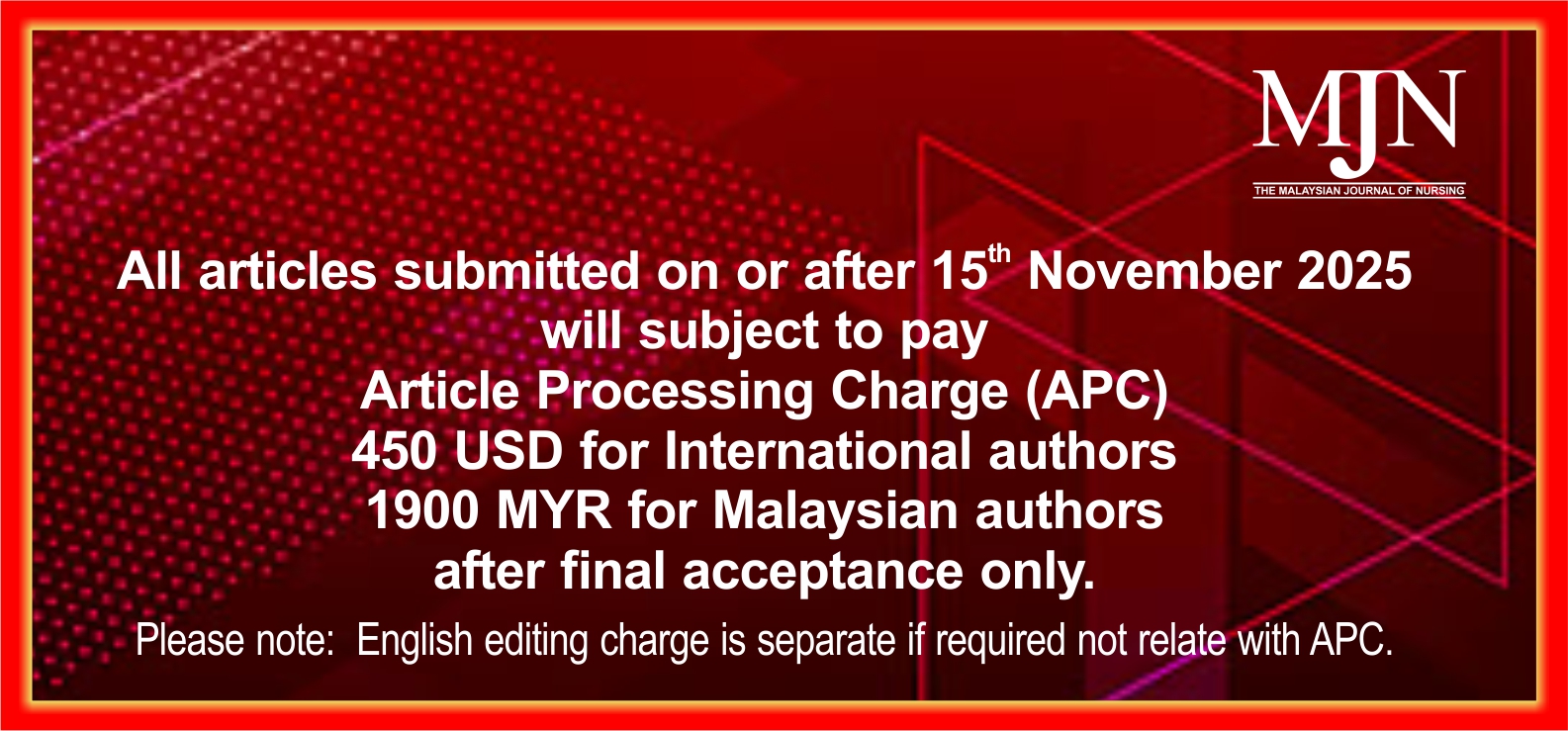Barriers to Healthcare Access among Visually Impaired in Iligan City, Philippines: A Qualitative Study
DOI:
https://doi.org/10.31674/mjn.2024.v16i02.021Abstract
Background: The visually impaired population continues to experience disparities in healthcare access, reducing their capacity to meet physical and mental needs. This study delved into the barriers visually impaired individuals face when accessing healthcare to determine how nurses, as front-line healthcare providers, might help this underserved population. Methods: This study employed a qualitative descriptive research design utilizing in-depth one-on-one interviews with fifteen visually impaired massage therapists in Iligan City, Philippines recruited through a purposive sampling technique. The researchers developed an interview guide with open-ended questions for the unstructured interview sessions. The interviews underwent a process of recording, transcription, and thematic analysis. Results: Several barriers discouraged visually impaired individuals from seeking medical care, including challenges related to accessing healthcare facilities due to a lack of support and transportation difficulties. Other issues include inadequate knowledge of healthcare access, fear of discrimination, negative experiences with health services, and financial constraints. Conclusion: Visually impaired individuals encounter complex barriers to healthcare, including the need for reliable assistance, inadequate transportation, limited support systems, and financial constraints. Additional challenges like insufficient social interactions, low health literacy, and discrimination further hinder their access to care. Financial issues often lead them to prioritize other needs, worsening their health. A comprehensive approach is needed to address these barriers, including enhancing support networks, improving accessibility, providing better assistive devices, and training healthcare personnel. Increasing health literacy and making healthcare more affordable are also crucial for creating a more inclusive system that effectively serves visually impaired individuals.
Keywords:
Healthcare Access, Massage Therapist, Visually ImpairedDownloads
References
Amalia, N., Rustam, M. Z. A., Rosarini, A., Wijayanti, D. R., & Riestiyowati, M. A. (2021). The Implementation of Electronic Medical Record (EMR) in the Development Health Care System in Indonesia. International Journal of Advancement in Life Sciences Research, 4(3), 8-12. https://doi.org/10.31632/ijalsr.2021.v04i03.002
Awidi, A., Wang, J., Varadaraj, V., Ali, M., Cai, C., Sommer, A., Ramulu, P., & Woreta, F. (2023). The impact of social determinants of health on vision loss from cataracts and cataract surgery utilization in the United States - A national health interview survey analysis. American Journal of Ophthalmology, 254, 44-53. https://doi.org/10.1016/j.ajo.2023.03.017
Babapour, A. R., Gahassab-Mozaffari, N., & Fathnezhad-Kazemi, A. (2022). Nurses’ job stress and its impact on quality of life and caring behaviors: a cross-sectional study. BMC Nursing, 21(1), 75. https://doi.org/10.1186/s12912-022-00852-y
Baclig, C. E. (2022). Sight Saving Month: Finding Light in Darkness. Inquirer.net. https://newsinfo.inquirer.net/1653791/sight-saving-month-finding-light-in-darkness. Accessed on 18th February, 2024.
Barman, D., & Mishra, M. (2020). How does eye care seeking behaviour change with increasing age and visual impairment? Intersectional analysis of older adults in the Indian Sundarbans. BMC Geriatrics, 20, 1-9. https://doi.org/10.1186/s12877-020-1438-y
Choi, S., Nanda, P., Yuen, K., & Ong, K. (2023). Bridging the gap in health literacy research: The inclusion of individuals with visual impairments. Patient Education and Counselling, 116, https://doi.org/10.1016/j.pec.2023.107932
Chu, H. Y., & Chan, H. S. (2022). Loneliness and social support among the middle-aged and elderly people with visual impairment. International Journal of Environmental Research and Public Health, 19(21), 14600. https://doi.org/10.3390/ijerph192114600
Clemente, K. A. P., Silva, S. V. D., Vieira, G. I., Bortoli, M. C. D., Toma, T. S., Ramos, V. D., & Brito, C. M. M. D. (2022). Barreiras ao acesso das pessoas com deficiência aos serviços de saúde: Uma revisão de escopo [Barriers to access to health services for people with disabilities: A scoping review]. Revista de Saúde Pública, 56, 64. https://doi.org/10.11606/s1518-8787.2022056003893
Dahlan, M., Listiningrum, P., & Wicaksana, D. (2022). Rights to Access of Public Facilities in Health Services for People with Disabilities. Indonesian Journal of Law and Society, 3(1), 25-48. https://doi.org/10.19184/ijls.v3i1.29226
Dassah, E., Aldersey, H., McColl, M. A., & Davison, C. (2018). Factors affecting access to primary health care services for persons with disabilities in rural areas: a “best-fit” framework synthesis. Global Health Research and Policy, 3, 1-13. https://doi.org/10.1186/s41256-018-0091-x
Demmin, D. L., & Silverstein, S. M. (2020). Visual impairment and mental health: Unmet needs and treatment options. Clinical Ophthalmology, 2020(14), 4229-4251. https://doi.org/10.2147/OPTH.S258783
Fraser, S., Beeman, I., Southall, K., & Wittich, W. (2019). Stereotyping as a barrier to the social participation of older adults with low vision: A qualitative focus group study. BMJ Open, 9(9), e029940. https://doi.org/10.1136/bmjopen-2019-029940
Glasziou, P., Straus, S., Brownlee, S., Trevena, L., Dans, L., Guyatt, G., Elshaug, A., Janett, R., & Saini, V. (2017). Evidence for underuse of effective medical services around the world. The Lancet, 390(10090), 169-177. http://dx.doi.org/10.1016/S0140-6736(16)30946-1
Gong, E., Holbrook, L., Kadlec, K., & Moresi, N. (2021). Doctors without disability awareness: The role of medical training in a profound healthcare barrier for people with disabilities. University of Washington Libraries, USA. http://hdl.handle.net/1773/46959
Grisafe, D., Varma, R., Burkemper, B., Xu, B., Torres, M., Crisp, A., Patino, C., & Cowdin, R. (2021). Impact of visual field loss on vision-specific quality of life in African Americans: The African American Eye Disease Study. American Journal of Ophthalmology, 229, 52-62. https://doi.org/10.1016/j.ajo.2021.02.008
Guan, X., Fu, M., Lin, F., Zhu, D., Vuillermin, D., & Shi, L. (2019). Burden of visual impairment associated with eye diseases: exploratory survey of 298 Chinese patients. BMJ Open, 9(9), e030561. https://doi.org/10.1136/bmjopen-2019-030561
Haque, O. S., & Stein, M. A. (2020). COVID-19 clinical bias, persons with disabilities, and human rights. Health and Human Rights, 22(2), 285–290. https://bpb-us-e1.wpmucdn.com/sites.harvard.edu/dist/f/680/files/2020/12/Haque.pdf . Accessed on 24th March, 2024.
Hashemi, G., Wickenden, M., Bright, T., & Kuper, H. (2020). Barriers to accessing primary healthcare services for people with disabilities in low and middle-income countries, A meta-synthesis of qualitative studies. Disability and Rehabilitation, 44(8), 1207–1220. https://doi.org/10.1080/09638288.2020.1817984
Hersh, M. (2020). Mental maps and the use of sensory information by blind and partially sighted people. ACM Transactions on Accessible Computing (TACCESS), 13(2), 1-32. https://doi.org/10.1145/3375279
Hong, M. J., Lee, C., Lee, C., Kim, Y. S., Jeong, J. Y., Park, J., Shin, D. W., & Shin, E. (2022). Are high medical costs incurred by people with disabilities excessive? Are high medical costs incurred by people with disabilities excessive?: An empirical analysis of Korean National Health Insurance Data. PloS One, 17(1). https://doi.org/10.1371/journal.pone.0262653
Hussain, S. F., Heinze, N., & Gomes, R. S. M. (2024). Health and comorbidities in minority ethnic adults living with visual impairment in the UK. Disabilities, 4(1), 79-100. https://doi.org/10.3390/disabilities4010006
Koca-Atabey, M., Öz, B., & Tekeş, B. (2022). Personal experiences of blind road users in traffic settings: An investigation based on the Interpretative Phenomenological Analysis. Journal of Transport & Health, 27, 101518. https://doi.org/10.1016/j.jth.2022.101518
Low, W. Y., Cao, M., De Vos, J., & Hickman, R. (2020). The journey experience of visually impaired people on public transport in London. Transport Policy, 97, 137-148. https://doi.org/10.1016/j.tranpol.2020.07.018
Magnusson, L., Kebbie, I., & Jerwanska, V. (2022). Access to health and rehabilitation services for persons with disabilities in Sierra Leone–focus group discussions with stakeholders. BMC Health Services Research, 22(1). https://doi.org/10.1186/s12913-022-08366-8
Martinez, S. S., Asorey, M. F., & Latas, A. P. (2024). Face to face: dialogues around visual impairment. European Journal of Special Needs Education, 1–14. https://doi.org/10.1080/08856257.2024.2331909
McClintock, H., Barg, F., Katz, S., Stineman, M., Krueger, A., Colletti, P., Boellstorff, T., & Bogner, H. (2016). Health care experiences and perceptions among people with and without disabilities. Disability and Health Journal, 9(1), 74–82. https://doi.org/10.1016/j.dhjo.2015.08.007
Mirzaei, F., Manduchi, R., & Kurniawan, S. (2018). Public transit accessibility: Blind passengers speak out. In Computers Helping People with Special Needs: 16th International Conference, ICCHP 2018, Linz, Austria, July 11-13, 2018, Proceedings, Part II 16 (pp. 277-282). Springer International Publishing, Germany. https://doi.org/10.1007/978-3-319-94274-2_38
Moscoso-Porras, M. G., & Alvarado, G. F. (2018). Association between perceived discrimination and healthcare-seeking behavior in people with a disability. Disability and Health Journal, 11(1), 93-98. https://doi.org/10.1016/j.dhjo.2017.04.002
Mugisa, G. & Kyakulaga, A. (2024). Challenges faced by visually impaired learners among patients attending eye health care services at Jinja Regional Referral Hospital. A cross-sectional study. SJ Ophthalmology Africa, 1(1), 6. https://doi.org/10.51168/cq7d7k15
Nguyen, J., & Gilbert, L. (2019). Health Literacy among Individuals with Disabilities: A Health Information National Trends Survey Analysis. The Permanente Journal, 23(4). https://doi.org/10.7812/TPP/19.034
Nuzzi, A., Becco, A., Boschiroli, A., Coletto, A., & Nuzzi, R. (2024). Blindness and visual impairment: Quality of life and accessibility in the city of Turin. Frontiers in Medicine, 11, 1361631. https://doi.org/10.3389/fmed.2024.1361631
O’Conor, R., Smith, S., Curtis, L., Benavente, J., Vicencio, D., Wolf, M. (2016). Mild visual impairment and its impact on self-care among older adults. Journal of Aging and Health, 30(3), 327-341. https://doi.org/10.1177/0898264316676406
Pelikan, J., Ganahl, K., & Roethin, F. (2018). Health literacy as a determinant, mediator and/or moderator of health: empirical models using the European Health Literacy Survey dataset. Global Health Promotion, 25(4), 57-66. https://do.org/10.1177/1757975918788300
Sanders, R., Gascoyne, B., Appleby, P., Rashida, S. A., & Jolley, E. (2021). Eye health service uptake among people with visual impairment and other functional difficulties in Bangladesh: A cross-sectional study with short-term follow up. International Journal of Environmental Research and Public Health, 18(17), 9068. https://doi.org/10.3390/ijerph18179068
Schwei, R. J., Johnson, T. P., Matthews, A. K., & Jacobs, E. A. (2017). Perceptions of negative health-care experiences and self-reported health behavior change in three racial and ethnic groups. Ethnicity & Health, 22(2), 156-168. https://doi.org/10.1080/13557858.2016.1244621
Schwennesen, N., Barghadouch, A., Olesen, K. (2018). Health Literacy and self-care among visually impaired people with type 1 diabetes in Denmark. Chronic Illness, 15(2), 157-164. https://doi.org/10.1177/1742395318789476
Senjam, S. S., & Singh, A. (2020). Addressing the health needs of people with disabilities in India. Indian Journal of Public Health, 64(1), 79. https://doi.org/10.4103/ijph.ijph_27_19
Sim, I. O. (2020). Analysis of the coping process among visually impaired individuals, using Interpretative Phenomenological Analysis (IPA). International Journal of Environmental Research and Public Health, 17(8), 2819. https://doi.org/10.3390/ijerph17082819
Sohrabi, M., Tumin, M., & Osman, A. F. (2018). Issues and challenges of public health accessibility among urban poor people: A case study of Malaysia, Iran and India. Malaysian Journal of Medical Research (MJMR), 2(4), 22-31. http://dx.doi.org/10.31674/mjmr.2018.v02i04.003
Soltani, S., Takian, A., Sari, A., Majdzadeh, R., & Kamali, M. (2019). Financial barriers to access to health services for adult people with disability in Iran: The challenges for universal health coverage. Iranian Journal of Public Health, 48(3), 508-515. https://doi.org/10.18502/ijph.v48i3.895
Stolwijk, M. L., Van Nispen, R. M. A., Van Der Ham, A. J., Veenman, E., & Van Rens, G. H. M. B. (2023). Barriers and facilitators in the referral pathways to low vision services from the perspective of patients and professionals: A qualitative study. BMC Health Services Research, 23(1). https://doi.org/10.1186/s12913-022-09003-0
Stormacq, C., Van den Broucke, S., & Wosinski, J. (2019). Does health literacy mediate the relationship between socioeconomic status and health disparities? Integrative review. Health Promotion International, 34(5), e1-e17. https://doi.org/10.1093/heapro/day062
Talaat, K., Fathi, O. T., Alamoudi, S. M., Alzahrani, M. G., Mukhtar, R. M., & Khan, M. A. (2021). Types of glaucoma and associated comorbidities among patients at King Abdulaziz Medical City, Jeddah. Cureus, 13(6), e15574. https://doi.org/10.7759/cureus.15574
Timilsina, A., Neupane, P., Pandey, J., Subedi, A., & Thapa, S. (2024). Exploring the healthcare access challenges faced by visually impaired young women in Nepal: Navigating sexual harassment and stigma within healthcare settings. Dialogues in Health, 4, 100171. https://doi.org/10.1016/j.dialog.2024.100171
Tong, A., Sainsbury, P., & Craig, J. (2007). Consolidated criteria for reporting qualitative research (COREQ): a 32-item checklist for interviews and focus groups. International Journal for Quality in Health Care, 19(6), 349-357. https://doi.org/10.1093/intqhc/mzm042
Vaismoradi, M., Turunen, H., & Bondas, T. (2013). Content analysis and thematic analysis: implications for conducting a qualitative descriptive study. Nursing & Health Sciences, 15(3), 398-405. https://doi.org/10.1111/nhs.12048
Wallace, L. G., Bradway, C., & Cacchione, P. Z. (2022). The relationship between sensory loss and health literacy in older adults: A systematic review. Geriatric Nursing, 47, 1–12. https://doi.org/10.1016/j.gerinurse.2022.06.003
Welp, A., Woodbury, R. B., McCoy, M. A., & Teutsch, S. M. (Eds.). (2017). Making eye health a population health imperative: Vision for tomorrow. National Academies Press, USA. https://doi.org/10.17226/23471
Wolsiefer, K., & Stone, J. (2019). Addressing bias in healthcare: Confrontation as a tool for bias reduction and patient and provider self-advocacy. In Confronting Prejudice and Discrimination (pp. 275-297). Academic Press. https://doi.org/10.1016/b978-0-12-814715-3.00013-8
World Health Organization. (2023, March 8). Increasing eye care interventions to address vision impairment: Technical brief. World Health Organization. https://www.who.int/publications/m/item/increasing-eye-care-interventions-to-address-vision-impairment. Access Date 15th March, 2024.
Published
How to Cite
Issue
Section
License
Copyright (c) 2024 The Malaysian Journal of Nursing (MJN)

This work is licensed under a Creative Commons Attribution-NonCommercial-NoDerivatives 4.0 International License.



































